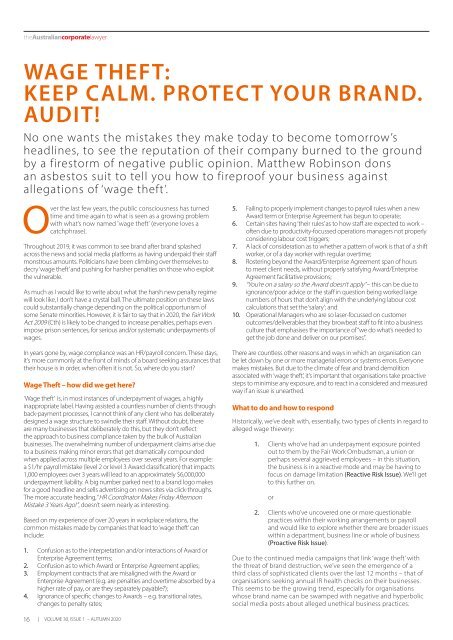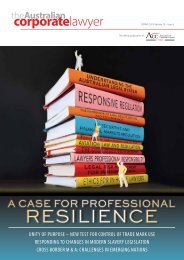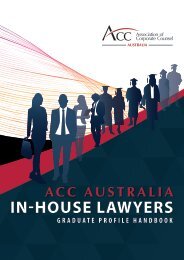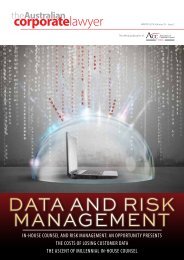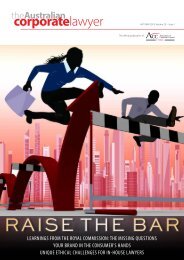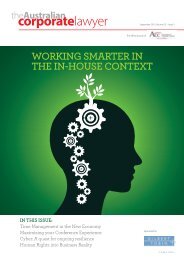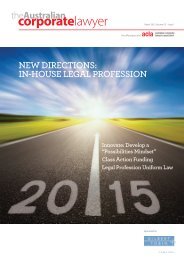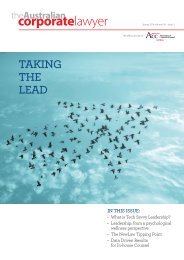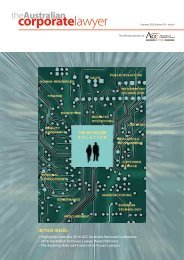Australian Corporate Lawyer - Autumn 2020
Australian Corporate Lawyer is the official publication of the Association of Corporate Counsel (ACC) Australia. The Autumn 2020 issue focuses on contract negotiation and features a range of articles covering topics including the importance of EQ for lawyers; managing employment rights in the social media age and addressing conflict in the workplace.
Australian Corporate Lawyer is the official publication of the Association of Corporate Counsel (ACC) Australia. The Autumn 2020 issue focuses on contract negotiation and features a range of articles covering topics including the importance of EQ for lawyers; managing employment rights in the social media age and addressing conflict in the workplace.
You also want an ePaper? Increase the reach of your titles
YUMPU automatically turns print PDFs into web optimized ePapers that Google loves.
the<strong>Australian</strong>corporatelawyer<br />
WAGE THEFT:<br />
KEEP CALM. PROTECT YOUR BRAND.<br />
AUDIT!<br />
No one wants the mistakes they make today to become tomorrow’s<br />
headlines, to see the reputation of their company burned to the ground<br />
by a firestorm of negative public opinion. Matthew Robinson dons<br />
an asbestos suit to tell you how to fireproof your business against<br />
allegations of ‘wage theft’.<br />
Over the last few years, the public consciousness has turned<br />
time and time again to what is seen as a growing problem<br />
with what’s now named 'wage theft' (everyone loves a<br />
catchphrase).<br />
Throughout 2019, it was common to see brand after brand splashed<br />
across the news and social media platforms as having underpaid their staff<br />
monstrous amounts. Politicians have been climbing over themselves to<br />
decry ‘wage theft’ and pushing for harsher penalties on those who exploit<br />
the vulnerable.<br />
As much as I would like to write about what the harsh new penalty regime<br />
will look like, I don’t have a crystal ball. The ultimate position on these laws<br />
could substantially change depending on the political opportunism of<br />
some Senate minorities. However, it is fair to say that in <strong>2020</strong>, the Fair Work<br />
Act 2009 (Cth) is likely to be changed to increase penalties, perhaps even<br />
impose prison sentences, for serious and/or systematic underpayments of<br />
wages.<br />
In years gone by, wage compliance was an HR/payroll concern. These days,<br />
it’s more commonly at the front of minds of a board seeking assurances that<br />
their house is in order, when often it is not. So, where do you start?<br />
Wage Theft – how did we get here?<br />
‘Wage theft’ is, in most instances of underpayment of wages, a highly<br />
inappropriate label. Having assisted a countless number of clients through<br />
back-payment processes, I cannot think of any client who has deliberately<br />
designed a wage structure to swindle their staff. Without doubt, there<br />
are many businesses that deliberately do this, but they don’t reflect<br />
the approach to business compliance taken by the bulk of <strong>Australian</strong><br />
businesses. The overwhelming number of underpayment claims arise due<br />
to a business making minor errors that get dramatically compounded<br />
when applied across multiple employees over several years. For example:<br />
a $1/hr payroll mistake (level 2 or level 3 Award classification) that impacts<br />
1,000 employees over 3 years will lead to an approximately $6,000,000<br />
underpayment liability. A big number parked next to a brand logo makes<br />
for a good headline and sells advertising on news sites via click-throughs.<br />
The more accurate heading, “HR Coordinator Makes Friday Afternoon<br />
Mistake 3 Years Ago! ”, doesn’t seem nearly as interesting.<br />
Based on my experience of over 20 years in workplace relations, the<br />
common mistakes made by companies that lead to ‘wage theft’ can<br />
include:<br />
1. Confusion as to the interpretation and/or interactions of Award or<br />
Enterprise Agreement terms;<br />
2. Confusion as to which Award or Enterprise Agreement applies;<br />
3. Employment contracts that are misaligned with the Award or<br />
Enterprise Agreement (e.g. are penalties and overtime absorbed by a<br />
higher rate of pay, or are they separately payable?);<br />
4. Ignorance of specific changes to Awards – e.g. transitional rates,<br />
changes to penalty rates;<br />
5. Failing to properly implement changes to payroll rules when a new<br />
Award term or Enterprise Agreement has begun to operate;<br />
6. Certain sites having ‘their rules’ as to how staff are expected to work –<br />
often due to productivity-focussed operations managers not properly<br />
considering labour cost triggers;<br />
7. A lack of consideration as to whether a pattern of work is that of a shift<br />
worker, or of a day worker with regular overtime;<br />
8. Rostering beyond the Award/Enterprise Agreement span of hours<br />
to meet client needs, without properly satisfying Award/Enterprise<br />
Agreement facilitative provisions;<br />
9. “You’re on a salary so the Award doesn’t apply” – this can be due to<br />
ignorance/poor advice or the staff in question being worked large<br />
numbers of hours that don’t align with the underlying labour cost<br />
calculations that set the ‘salary’; and<br />
10. Operational Managers who are so laser-focussed on customer<br />
outcomes/deliverables that they browbeat staff to fit into a business<br />
culture that emphasises the importance of “we do what’s needed to<br />
get the job done and deliver on our promises”.<br />
There are countless other reasons and ways in which an organisation can<br />
be let down by one or more managerial errors or systems errors. Everyone<br />
makes mistakes. But due to the climate of fear and brand demolition<br />
associated with ‘wage theft’, it’s important that organisations take proactive<br />
steps to minimise any exposure, and to react in a considered and measured<br />
way if an issue is unearthed.<br />
What to do and how to respond<br />
Historically, we’ve dealt with, essentially, two types of clients in regard to<br />
alleged wage thievery:<br />
1. Clients who’ve had an underpayment exposure pointed<br />
out to them by the Fair Work Ombudsman, a union or<br />
perhaps several aggrieved employees – in this situation,<br />
the business is in a reactive mode and may be having to<br />
focus on damage limitation (Reactive Risk Issue). We’ll get<br />
to this further on.<br />
or<br />
2. Clients who’ve uncovered one or more questionable<br />
practices within their working arrangements or payroll<br />
and would like to explore whether there are broader issues<br />
within a department, business line or whole of business<br />
(Proactive Risk Issue).<br />
Due to the continued media campaigns that link ‘wage theft’ with<br />
the threat of brand destruction, we’ve seen the emergence of a<br />
third class of sophisticated clients over the last 12 months – that of<br />
organisations seeking annual IR health checks on their businesses.<br />
This seems to be the growing trend, especially for organisations<br />
whose brand name can be swamped with negative and hyperbolic<br />
social media posts about alleged unethical business practices.<br />
16 | VOLUME 30, ISSUE 1 – AUTUMN <strong>2020</strong>


